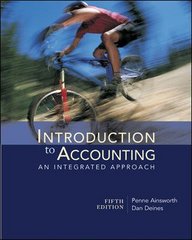Question
1. If a bond sold at 98, its stated rate of interest would be: a. higher than the market rate of interest b. lower than
1. If a bond sold at 98, its stated rate of interest would be:
a. higher than the market rate of interest
b. lower than the market rate of interest
c. equal to the market rate of interest
d. unrelated to the market rate of interest
2. Which of following statements correctly describes the accounting for
bonds that were issued at a discount?
a. The market rate of interest is less than the stated rate.
b. The interest expense over the life of the bonds will be less than the
total interest payments.
c. The present value of the bonds is greater than the bonds maturity
value.
d. The carrying value of the bonds increases every time interest is paid.
3. On January 1, 2015, Final, Inc., issued $400,000, 12% bonds. Interest is
payable semi-annually on June 30 and December 31. The issue price
was $413,153 based on a 10% market rate. Assuming the effective-
interest method of amortization is used, what is the interest expense at
June 30, 2015 (round to the nearest dollar)?
a. $20,000
b. $20,658 $413,153 x .05 = $20,658
c. $24,000
d. $24,789
Chapter 11 Questions
1. The par value of a class of capital stock:
is greater than market value
is less than market value
is equal to market value
is unrelated to market value
2. Full-Of-It, Inc., was authorized to issue 5,000 shares of common stock. The company issued 4,000 shares and repurchased 500 shares of treasury stock. The number of shares considered in the determination of earnings per share is:
5,000
4,500
4,000
3,500 4,000 500 = 3,500
3. When a company repurchases its own stock:
total assets are unaffected
total assets decrease
total equity decreases
b and c
4. At the end of the accounting period I-Have-Had-Enough Company had $2,000 of par value common stock outstanding, additional paid-in capital of $3,000, retained earnings of $7,000, and $1,000 of treasury stock. The total amount of stockholders equity is:
$9,000
$10,000
$11,000 $2,000 + $3,000 + $7,000 $1,000 = $11,000
$13,000
5. Not-Soon-Enough Enterprises purchased 1,000 shares of its own $5 par value common stock. The cost of the stock was $12 per share. Which general journal entry below reflects this transaction?
a. Treasury stock 12,000
Common stock 5,000
Additional paid-in capital 7,000
b. Cash 12,000
Treasury stock 5,000
Additional paid-in capital 7,000
c. Treasury stock 12,000
Cash 12,000
d. Common stock 5,000
Retained earnings 7,000
Cash 12,000
6. The distribution of a stock dividend will:
increase contributed capital
decrease retained earnings.
not effect total stockholders equity
All of the above
7. At the time that End-It-All, Inc., affected a 2 for 1 stock split, the company had 1,000 shares of $5 par value common stock outstanding. Additional paid-in capital and retained earnings were $14,000 and $20,000, respectively. Immediately after the stock split:
the balance in the retained earnings account would be $15,000
total contributed capital would be $20,000
the balance in the common stock account would be $10,000
the balance in the common stock account would be $5,000
8. I-Hope-N-Pray Company announced a 2-for-1 stock split on 12,000 shares of $5 par value common stock. Immediately after the split, the par value per share, number of shares outstanding, and total par value outstanding would be:
Par value/share Number of shares Total par outstanding
a. $5.00 24,000 $120,000
b. $5.00 12,000 $60,000
c. $2.50 24,000 $60,000
d. $2.50 12,000 $30,000
9. Cant-Be-Soon-Enough Associates has the following number of shares outstanding:
Cumulative, 8% preferred stock, $100 par 1,000 shares
Common stock, $10 par 10,000 shares
No dividend had been declared in either 2013 or 2014. In 2015, the company declared a $44,000 cash dividend. How much will be paid to the common shareholders?
$20,000 $44,000 3(8% x $100 par x 1,000 shares) = $20,000
$28,000
$36,000
$40,000
Chapter 12 Questions
1. Which of the following would not be a cash flow from financing activities?
Issuance of common stock
Borrowing on a long-term note payable
Payment of interest on bonds payable
Repayment of the face amount of bonds payable
2. Which of the following would not be a cash flow from operating activities?
Cash received for interest
Cash dividends paid
Cash paid for interest
Cash paid for inventory
Step by Step Solution
There are 3 Steps involved in it
Step: 1

Get Instant Access to Expert-Tailored Solutions
See step-by-step solutions with expert insights and AI powered tools for academic success
Step: 2

Step: 3

Ace Your Homework with AI
Get the answers you need in no time with our AI-driven, step-by-step assistance
Get Started


